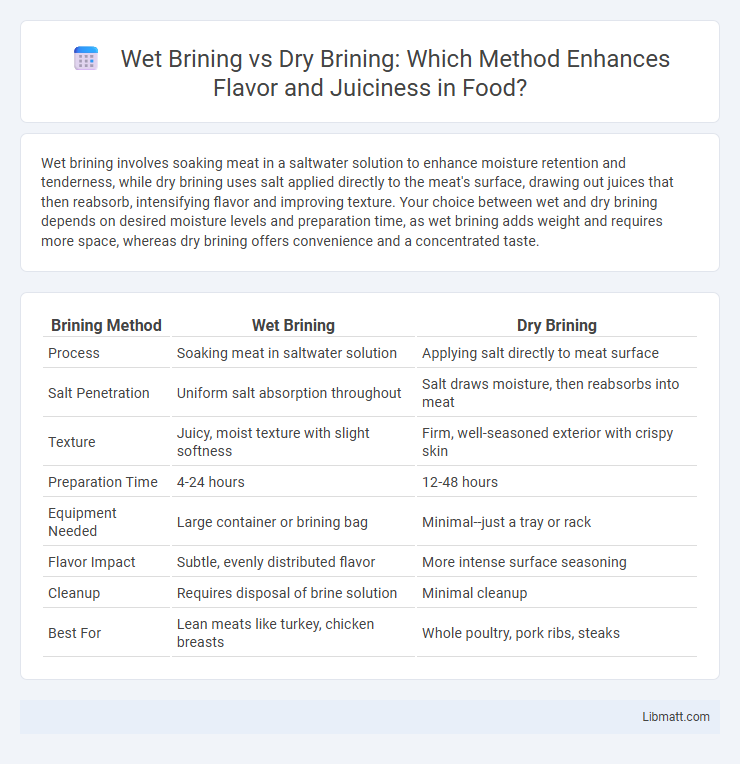Wet brining involves soaking meat in a saltwater solution to enhance moisture retention and tenderness, while dry brining uses salt applied directly to the meat's surface, drawing out juices that then reabsorb, intensifying flavor and improving texture. Your choice between wet and dry brining depends on desired moisture levels and preparation time, as wet brining adds weight and requires more space, whereas dry brining offers convenience and a concentrated taste.
Table of Comparison
| Brining Method | Wet Brining | Dry Brining |
|---|---|---|
| Process | Soaking meat in saltwater solution | Applying salt directly to meat surface |
| Salt Penetration | Uniform salt absorption throughout | Salt draws moisture, then reabsorbs into meat |
| Texture | Juicy, moist texture with slight softness | Firm, well-seasoned exterior with crispy skin |
| Preparation Time | 4-24 hours | 12-48 hours |
| Equipment Needed | Large container or brining bag | Minimal--just a tray or rack |
| Flavor Impact | Subtle, evenly distributed flavor | More intense surface seasoning |
| Cleanup | Requires disposal of brine solution | Minimal cleanup |
| Best For | Lean meats like turkey, chicken breasts | Whole poultry, pork ribs, steaks |
Introduction to Wet and Dry Brining
Wet brining involves submerging meat in a saltwater solution to enhance moisture retention and tenderness, while dry brining uses a salt rub applied directly to the meat's surface to achieve similar effects without added liquid. Wet brines typically contain water, salt, and sometimes sugar or spices, creating a solution that penetrates the meat through osmosis. Dry brining leverages salt's ability to draw out moisture that then dissolves the salt, forming a natural brine that reabsorbs into the meat, improving flavor and texture.
What Is Wet Brining?
Wet brining involves soaking meat in a saltwater solution typically mixed with herbs and spices to enhance moisture retention and flavor. This method helps your meat stay juicy by allowing the salt to penetrate and break down muscle proteins. Wet brining is especially effective for poultry and lean cuts that tend to dry out during cooking.
What Is Dry Brining?
Dry brining involves rubbing salt directly onto the meat's surface, allowing it to penetrate and enhance flavor and moisture retention through a natural osmosis process. Unlike wet brining, which submerges meat in a saltwater solution, dry brining requires less space and results in a crisper outer texture after cooking. You'll achieve tender, juicy results by seasoning your meat well in advance, letting the salt draw out juices that are reabsorbed for optimal seasoning.
Key Differences Between Wet and Dry Brining
Wet brining involves soaking meat in a saltwater solution, allowing it to absorb moisture and seasoning evenly, while dry brining requires rubbing salt directly onto the meat's surface to draw out and then reabsorb juices, enhancing flavor concentration. Wet brining typically results in juicier meat due to increased water retention, whereas dry brining intensifies the natural taste and improves texture without added liquid. Choosing between these methods depends on your preference for moisture levels and flavor intensity in the final dish.
Flavor Profiles: Wet Brine vs Dry Brine
Wet brining infuses meat with a juicy, savory flavor by soaking it in a saltwater solution often enhanced with herbs, sugar, and spices, leading to a more uniformly seasoned and moist result. Dry brining relies on salt and optional seasonings rubbed directly onto the meat's surface, concentrating flavors and creating a crispy, caramelized crust while preserving the meat's natural taste. Your choice between wet brine and dry brine will impact the texture and complexity of flavors, with wet brining offering juiciness and mild seasoning, and dry brining providing intensified taste and a firmer bite.
Texture Effects on Meat
Wet brining enhances meat texture by increasing moisture retention, resulting in juicier and more tender cuts due to the salt solution penetrating the muscle fibers. Dry brining improves texture by drawing out the meat's natural juices, then allowing them to reabsorb, which intensifies flavor and creates a firmer, more concentrated bite. Your choice between wet and dry brining will significantly impact the meat's final texture, making it either more succulent or more robust.
Best Meats for Wet Brining
Wet brining works exceptionally well for lean meats like turkey, chicken, and pork chops, which tend to dry out during cooking. The saltwater solution enhances moisture retention and flavor, making it ideal for these cuts that benefit from additional juiciness. You will achieve tender, juicy results especially with poultry and lean pork when using wet brining compared to dry brining.
Best Meats for Dry Brining
Dry brining is especially effective for thick cuts of beef, pork, and poultry, as it helps retain moisture and enhances natural flavors without adding excess saltwater. Meats like ribeye steaks, pork chops, and whole chickens benefit from the salt penetrating evenly, resulting in a juicy and tender texture. Your choice of dry brining will improve the meat's ability to trap moisture during cooking, making it ideal for cuts that need a concentrated, flavorful crust.
Time & Convenience Comparison
Wet brining typically requires 12 to 24 hours to fully infuse moisture and flavor into meat, making it a longer process that demands refrigeration space for the brine solution. Dry brining usually takes less time, around 6 to 12 hours, and offers greater convenience by eliminating the need for a large liquid container or extra refrigerator space. For home cooks seeking faster preparation and minimal cleanup, dry brining provides a more efficient option without sacrificing juiciness or seasoning.
Choosing the Right Brining Method
Choosing the right brining method depends on your desired flavor intensity and time available for preparation. Wet brining immerses meat in a saltwater solution, enhancing moisture retention and tenderness, ideal for poultry and pork requiring longer brining times. Dry brining uses coarse salt rubbed directly onto the meat's surface, concentrating flavors and producing a crispier skin, perfect for faster preparation and meats like steak or chicken.
wet brining vs dry brining Infographic

 libmatt.com
libmatt.com